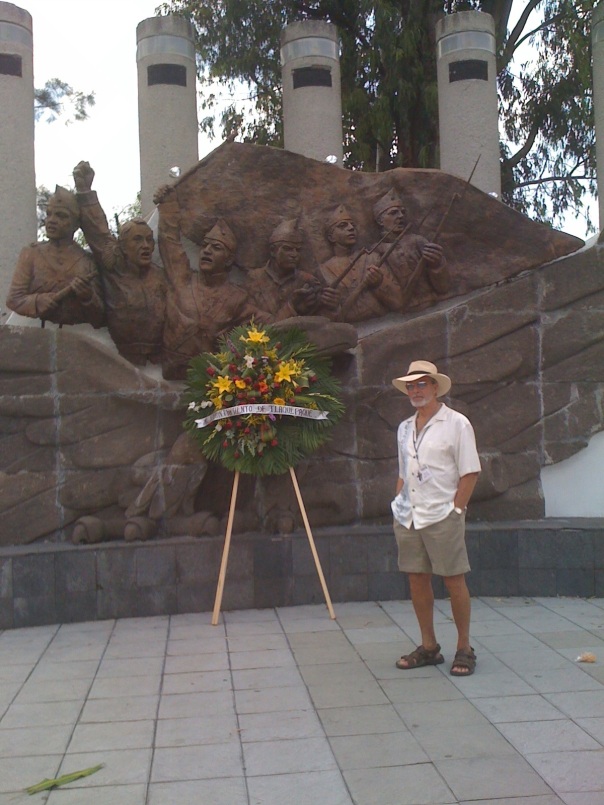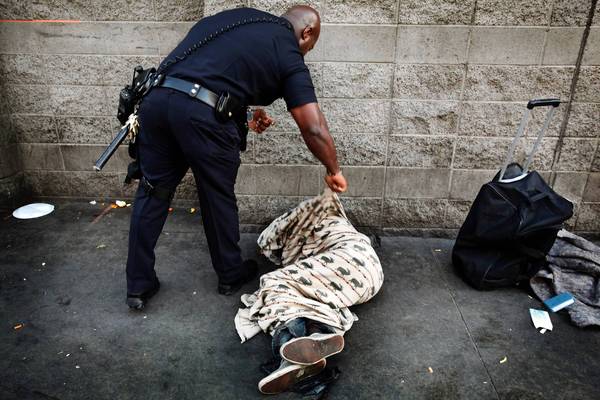This is a nicely done story, the real deal, by former LAPD cop and ex-sheriff of Jerome, Idaho, James D. Weaver. Enjoy!
West Los Angeles Division, Bel Air, 1980’s
I’ve just arrived for work when Officer Bob Stout, aka “Fatty,” the guy who coordinates all off duty cop jobs, approaches me. Bob tells me I am up for the next assignment. He maintains a list of officers who want to work off duty – the pay matches the LAPD’s hourly wage, and serves to keep the bill collectors off our backs. Having child support and numerous monthly payments to meet, thanks to my recent divorce, I gladly reply, “I’m your guy.”
“This job only became available because the vice guys are too busy,” Bob says.
He tells me I am to meet with the manager of a hotel who has a prostitution problem. Right there, Bob has gotten my attention. I’m used to high school dances, athletic events, and private parties, that sort of thing.
After filling out a Form 1.47 (Permit for Outside Employment), I call the hotel and am connected to a Mr. Checkers, the manager. I explain the reason for my call.
“I’d like to meet with you, ASAP,” Checkers says.
A short time later, I’m in his office. I sit on the opposite side of his fancy executive desk. As if I can’t tell already, he tells me that his hotel is high-end, very private, and extremely discreet. As part of their service, the concierge obliges those male guests who occasionally request a female companion to accompany them to business dinners, or simply to have a cocktail with.
Checkers says, “Jim let’s cut to the chase. Most of the ladies are high-class call girls. You know—top of the line. We don’t get too bothered by it, as our policy is what happens here, stays here.”
He isn’t telling me anything I don’t already know. The hotel’s Bistro Lounge is home to the west-side “beautiful” people.
“Jim, one such lady, Misty, is stealing money, credit cards and jewelry from her ‘dates.’ Naturally, the guests she victimizes don’t want the police involved—the embarrassment, you know—and we prefer it that way, but she is posing a problem—risking the hotel’s reputation.”
Checkers leans forward, elbows on his desk.
“Bob Stout assured me he would send over someone like you, Jim, to work Misty—catch her with the goods, so to speak . . . and so, I went ahead and set up a date with her for next Friday night at 9 o’clock, here at the Bistro Lounge. I gave her the name Wally Woodstock. Misty told me she would be in a white dress, and would wear her red hair down over her shoulders. I told her which suite went along with the Woodstock name.”
Sitting back, he adds, “I’ve arranged to have a BMW in the garage for your disposal, should you need it, and I will provide you beforehand with $1,000 in marked bills—also, dinner reservations in the Lounge have been made under the name ‘Woodstock.’”
Checkers then says, “If you make the arrest, please be very discreet.”
“No problem, sir, but I will need a partner as a backup and witness.”
Checkers quickly agrees to pay for the second officer.
Later that day I meet with my long-time partner, Ron, and give him the scoop. He’s up for it, saying, “I’ve never been in the fancy joint.”
“Yeah right. OK, Ron, when I get the violation, I’ll say ‘fantastic,’” and then you bust on in. OK?”
He nods, his face forming a Cheshire cat grin. “I bet it will be, too.”
We review the legal elements needed for a violation of 647.B (Prostitution) in the California Penal Code—basically: naming the type of sex act, and hearing the offered price for said act.
Friday night, Ron and I arrive at the hotel, right on schedule. As expected, the suite is “top floor” quality. I hand Ron a key. Without having to say a word, I know he will watch my back and be ready for any problems. Even though he’s a carefree character, he knows how to take care of business.
We go down to the bar and take up our positions. The barroom is doing a good business, a place where guests relax while waiting for their table in the Lounge.
Around 9:15 pm, I spot the redhead, my date. Who wouldn’t? She jounces into the bar wearing a low-cut white dress, allowing her small breasts to rise visibly. Her hair hangs to the center of her back. Over her shoulders?
As she approaches the bar, several men’s eyes follow her sashaying hips.
I step up. “Misty?”
“Mr. Woodstock?”
“The one and only.”
I take her arm and lead her to my table. It’s set up for two. Candlelight flickers between us as our drinks are served. Soon, her leg is against mine. She also squeezes my hand.
“I’m sorry I’m late—you know how horrible LA traffic can be.” Her emerald-green eyes, twinkling from the golden flame, gaze at me longingly. “May I call you by your first name?”
“Sure . . . it’s Wally.”
“Wally . . . I like that. Well, Wally, I promise I will make it up to you.”
Casually, I scan the bar. Ron holds his favorite drink, a Glenlivet, neat. Typical Ron, he’s jawboning with a busty cocktail waitress.
After several vodka-and-Seven’s, the maitre d’ escorts Misty and me to our table in the dimly lit Bistro Lounge. I have to agree with what I’d heard: it is an ideal place for a rendezvous like the one we’re supposedly having.
Once seated, Misty again presses her leg next to mine. Her tongue peeks over her ruby lips, moistening them as she bends slightly toward me, enough to give me an eyeful of milky breasts, a smile on her made-up face.
She orders a lobster; I smile and do the same. I also order a bottle of Dom Pérignon. We chat about what is going on in our lives over dinner. During dessert, Misty gets down to business.
“Wally . . . I think I’d like to have an after-dinner drink.” Her tone is questioning.
“I would like that,” I quickly say, admittedly feeling a rise in my groin.
“Wally . . . I like you. Would you mind if we had it in your room?”
As we walk out of the Lounge, I look for Ron. He’s nowhere in sight. I should be concerned, but I’m not. The drinks, the mood of the evening, and my groin have me feeling no pain. It’s about show time. I must focus on the bust—not hers, Jimbo!
We enter the suite and I immediately ring room service for another bottle of Dom. Misty is sashaying in front of me, giving me a seductive stare. Thankfully, the bellhop soon knocks at the door. After he wheels in the cart with the bottle settled in a bucket of ice, I ask him to open the champagne. He does, and fills two glass flutes. I tip him and he departs.
Simultaneously, Misty throws her arms around me, blows in my ear, nibbles my earlobe, and kisses my neck. I’m getting tumescent.
Things are moving way too fast.
I quickly untangle myself. “Let me wash up, hon—enjoy your Dom.”
When I return she is on the sofa, down to her pink underwear and lying on her side. One of the best bodies I have ever seen.
“Come and get it cowboy,” she purrs then empties her stem glass.
Having no vice experience, I only know I need to get a violation. But she hasn’t even hinted about wanting money. I can’t expose myself, especially not with a hard-on—then she saves my ass.
“But first, cowboy, it’ll cost you $500 for a half-and-half (street vernacular for a blowjob and a straight lay.)
Sighing in relief, I say, “OK, lady—but first, let me see that fine body of yours.”
Misty eyes the swelling in my crotch, and quickly slips out of her bra and panties.
“Misty, you’re fantastic,” I say loudly with my head facing toward the hallway door.
I stand stupidly waiting for Ron to bust into the suite.
No Ron.
I repeat, even more loudly, “yeah, you’re really fantastic!”
I hear a scraping noise at the door, then a banging.
Misty sits up, obviously startled.
Ron staggers in and shouts, “Los Angeles Police, you’re unner arrest.” His words are slurred.
Misty immediately puts on the sob scene, like she’s been here before. “Can’t we work something out?”
I read Misty her legal rights.
“I got nothin’ to say to you fuckin’ assholes,” she spits out.
I landline Dispatch, and request a radio car to transport her to the West Los Angeles Station.
Later, while completing the necessary reports, Ron joins me.
“Misty just beat us back to the streets, pardner—she made bail.”
“Sorry I’m so slow.” Ron knows that report writing isn’t my favorite piece of police work.
“No problemo. I’m heading out, Jimbo—see you at Westside Frank’s for a nightcap.”
“OK, give me thirty.”
Arriving at Frank’s, a cop bar, I see Ron sitting with Fatty Bob. Feeling magnanimous, I announce, “I’m buying gents.”
I open my calfskin wallet to pay for the round.
“Oh shit!”












